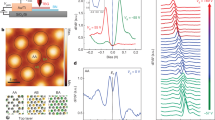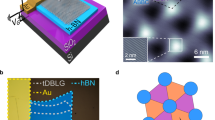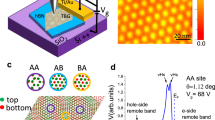Abstract
The emergence of controlled, two-dimensional moiré materials1,2,3,4,5,6 has uncovered a new platform for investigating topological physics7,8,9. Twisted double bilayer graphene has been predicted to host a topologically non-trivial gapped phase with Chern number equal to two at charge neutrality, when half the flat bands are filled8,9. However, it can be difficult to diagnose topological states using a single measurement because it is ideal to probe the bulk and edge properties at the same time. Here we report a combination of chemical potential measurements, transport measurements and theoretical calculations that show that twisted double bilayer graphene can host metallic edge transport in addition to simultaneously being insulating in the bulk. A Landauer–Büttiker analysis of the measurements on multi-terminal samples allows us to quantitatively assess the edge-state scattering. We interpret these results as signatures of the predicted topological phase at charge neutrality, but further characterization of the edge transport is required to be certain.
This is a preview of subscription content, access via your institution
Access options
Access Nature and 54 other Nature Portfolio journals
Get Nature+, our best-value online-access subscription
$29.99 / 30 days
cancel any time
Subscribe to this journal
Receive 12 print issues and online access
$209.00 per year
only $17.42 per issue
Buy this article
- Purchase on Springer Link
- Instant access to full article PDF
Prices may be subject to local taxes which are calculated during checkout




Similar content being viewed by others
Data availability
Source data for Figs. 1–4 are provided with this paper. Data that support the findings of this study are available from the corresponding author upon reasonable request.
Code availability
A sample Mathematica code for performing the Landauer–Büttiker inversion is implemented for public use at https://doi.org/10.5281/zenodo.5539921. Any software package that can perform a singular-value decomposition is also suitable.
References
Cao, Y. et al. Correlated insulator behaviour at half-filling in magic-angle graphene superlattices. Nature 556, 80–84 (2018).
Cao, Y. et al. Unconventional superconductivity in magic-angle graphene superlattices. Nature 556, 43–50 (2018).
Burg, G. W. et al. Correlated insulating states in twisted double bilayer graphene. Phys. Rev. Lett. 123, 197702 (2019).
Shen, C. et al. Correlated states in twisted double bilayer graphene. Nat. Phys. 16, 520–525 (2020).
Cao, Y. et al. Tunable correlated states and spin-polarized phases in twisted bilayer–bilayer graphene. Nature 583, 215–220 (2020).
Liu, X. et al. Tunable spin-polarized correlated states in twisted double bilayer graphene. Nature 583, 221–225 (2020).
Wu, F., Lovorn, T., Tutuc, E., Martin, I. & MacDonald, A. H. Topological insulators in twisted transition metal dichalcogenide homobilayers. Phys. Rev. Lett. 122, 086402 (2019).
Chebrolu, N. R., Chittari, B. L. & Jung, J. Flat bands in twisted double bilayer graphene. Phys. Rev. B 99, 235417 (2019).
Koshino, M. Band structure and topological properties of twisted double bilayer graphene. Phys. Rev. B 99, 235406 (2019).
Sharpe, A. L. et al. Emergent ferromagnetism near three-quarters filling in twisted bilayer graphene. Science 365, 605–608 (2019).
Serlin, M. et al. Intrinsic quantized anomalous Hall effect in a moiré heterostructure. Science 367, 900–903 (2020).
Wu, S., Zhang, Z., Watanabe, K., Taniguchi, T. & Andrei, E. Y. Chern insulators, van Hove singularities and topological flat bands in magic-angle twisted bilayer graphene. Nat. Mater. 20, 488–494 (2021).
Das, I. et al. Symmetry-broken Chern insulators and Rashba-like Landau-level crossings in magic-angle bilayer graphene. Nat. Phys. 17, 710–714 (2021).
Park, J. M., Cao, Y., Watanabe, K., Taniguchi, T. & Jarillo-Herrero, P. Flavour Hund’s coupling, Chern gaps and charge diffusivity in moiré graphene. Nature 592, 43–48 (2021).
Nuckolls, K. P. et al. Strongly correlated Chern insulators in magic-angle twisted bilayer graphene. Nature 588, 610–615 (2020).
Choi, Y. et al. Correlation-driven topological phases in magic-angle twisted bilayer graphene. Nature 589, 536–541 (2021).
Bistritzer, R. & MacDonald, A. H. Moiré bands in twisted double-layer graphene. Proc. Natl Acad. Sci. USA 108, 12233–12237 (2011).
Kim, S. et al. Direct measurement of the Fermi energy in graphene using a double-layer heterostructure. Phys. Rev. Lett. 108, 116404 (2012).
Lee, K. et al. Chemical potential and quantum Hall ferromagnetism in bilayer graphene. Science 345, 58–61 (2014).
Burg, G. W. et al. Evidence of emergent symmetry and valley Chern number in twisted double-bilayer graphene. Preprint at https://arxiv.org/abs/2006.14000 (2020).
Sinha, S. et al. Bulk valley transport and Berry curvature spreading at the edge of flat bands. Nat. Commun. 11, 5548 (2020).
He, M. et al. Symmetry breaking in twisted double bilayer graphene. Nat. Phys. 17, 26–30 (2021).
Nichele, F. et al. Edge transport in the trivial phase of InAs/GaSb. New J. Phys. 18, 083005 (2016).
Chu, Y. et al. Phonons and quantum criticality revealed by temperature linear resistivity in twisted double bilayer graphene. Preprint at https://arxiv.org/abs/2104.05406 (2021).
Büttiker, M. Four-terminal phase-coherent conductance. Phys. Rev. Lett. 57, 1761–1764 (1986).
Büttiker, M. Absence of backscattering in the quantum Hall effect in multiprobe conductors. Phys. Rev. B 38, 9375–9389 (1988).
König, M. et al. Quantum spin Hall insulator state in HgTe quantum wells. Science 318, 766–770 (2007).
Büttiker, M. Symmetry of electrical conduction. IBM J. Res. Dev. 32, 317–334 (1988).
Rozhkov, A. V., Sboychakov, A. O., Rakhmanov, A. L. & Nori, F. Electronic properties of graphene-based bilayer systems. Phys. Rep. 648, 1–104 (2016).
Da Costa, D. R., Zarenia, M., Chaves, A., Farias, G. A. & Peeters, F. M. Energy levels of bilayer graphene quantum dots. Phys. Rev. B 92, 115437 (2015).
Acknowledgements
We thank Z.-D. Song and B. Lian for helpful discussions. The work at The University of Texas at Austin was supported by the National Science Foundation (NSF) grants MRSEC DMR-1720595, EECS-1610008 and EECS-2122476; Army Research Office under grant no. W911NF-17-1-0312; and the Welch Foundation grant F-2018-20190330. Work was partly done at the Texas Nanofabrication Facility supported by the NSF grant no. NNCI-2025227. B.A.B. was supported by the DOE grant no. DE-SC0016239, the Schmidt Fund for Innovative Research, Simons Investigator grant no. 404513, the Packard Foundation, the Gordon and Betty Moore Foundation through grant no. GBMF8685 towards the Princeton theory programme, and a Guggenheim Fellowship from the John Simon Guggenheim Memorial Foundation. Further support was provided by the NSF-EAGER no. DMR 1643312, NSFMRSEC no. DMR-1420541 and DMR-2011750, ONR no. N00014-20-1-2303, BSF Israel US foundation no. 2018226, and the Princeton Global Network Funds. J.H.-A. acknowledges support from a Marshall Scholarship funded by the Marshall Aid Commemoration Commission. A.H.M. acknowledges support from the Welch Foundation grant F1473. K.W. and T.T. acknowledge support from the Elemental Strategy Initiative conducted by the MEXT, Japan (grant no. JPMXP0112101001), and JSPS KAKENHI (grant nos. JP19H05790 and JP20H00354).
Author information
Authors and Affiliations
Contributions
Y.W., G.W.B. and E.T. conceived the experiments. Y.W. and G.W.B. fabricated the samples and performed the experiments. J.H.-A., J.Z., A.H.M. and B.A.B. performed the theoretical calculations and analysis. K.W. and T.T. provided the hBN crystals. Y.W., J.H.-A, G.W.B., A.H.M. B.A.B. and E.T. analysed the data. Y.W., J.H.-A. and E.T. wrote the manuscript with input from all authors.
Corresponding author
Ethics declarations
Competing interests
The authors declare no competing interests.
Additional information
Peer review information Nature Physics thanks the anonymous reviewers for their contribution to the peer review of this work.
Publisher’s note Springer Nature remains neutral with regard to jurisdictional claims in published maps and institutional affiliations.
Supplementary information
Supplementary Information
Supplementary Sections A–F and Figs. 1–8.
Source data
Source Data Fig. 1
Source data for Fig. 1c,d.
Source Data Fig. 2
Source data for Fig. 2.
Source Data Fig. 3
Source data for Fig. 3.
Source Data Fig. 4
Source data for Fig. 4a–c,e,f.
Rights and permissions
About this article
Cite this article
Wang, Y., Herzog-Arbeitman, J., Burg, G.W. et al. Bulk and edge properties of twisted double bilayer graphene. Nat. Phys. 18, 48–53 (2022). https://doi.org/10.1038/s41567-021-01419-5
Received:
Accepted:
Published:
Issue Date:
DOI: https://doi.org/10.1038/s41567-021-01419-5
This article is cited by
-
Tunable moiré materials for probing Berry physics and topology
Nature Reviews Materials (2024)
-
Correlation, superconductivity and topology in graphene moiré superlattice
Frontiers of Physics (2023)
-
Spontaneous time-reversal symmetry breaking in twisted double bilayer graphene
Nature Communications (2022)



